SEARCH
Monsoon Travel in India: How to Make the Most of the Rainy Season
India’s monsoon can be a game‑changer for travelers. While many think rain means staying indoors, the right plan lets you see lush landscapes, cooler temps, and fewer crowds. Below are practical pointers so you can enjoy the wet season without hassle.
When to Go and Where to Go
The monsoon typically hits the west coast in June and moves eastward by September. If you love green hills and waterfalls, head to the Western Ghats – places like Mahabaleshwar, Coorg, and Munnar turn into a misty paradise. The north gets rain later, so Kashmir and Himachal enjoy clear skies in July before the showers start. For beach lovers, Goa and Kerala’s backwaters are still beautiful; the rain softens the heat and the sea stays warm.
Each region has a peak month. June‑July works best for the west coast, August‑September for the east, and October‑December for the Himalayas. Pick a window that matches the scenery you want, and you’ll avoid the heaviest downpours.
Pack Smart and Stay Safe
Quick packing can save you from soggy shoes and cold evenings. Bring a lightweight rain jacket, a waterproof backpack cover, and quick‑dry clothing. Slip‑on shoes with good grip are a must for slippery streets and trail paths. Don’t forget a small umbrella – it’s handy on city walks but not ideal on hikes.
Health-wise, drink bottled water and wash fruits before eating. Mosquitoes become more active, so pack repellent and consider a short anti‑malaria course if you travel to jungle areas. Carry a basic first‑aid kit with band‑aids, antiseptic wipes, and any personal meds.
Transport can be slower during the monsoon because of water‑logged roads. Check local weather updates before heading out, and give yourself extra travel time. Trains run on schedule, but road trips may need a flexible plan.
Make the Most of Rainy‑Season Activities
Rain adds drama to most attractions. Waterfalls like Athirappilly in Kerala or Dudhsagar in Goa become thunderous sights you won’t see in dry months. Wildlife sanctuaries such as Bandipur or Periyar are lush and full of animal activity – early mornings are best for sightings.
City tours get a fresh vibe too. In Mumbai, the monsoon lights up the sky with spectacular lightning over the sea, and street food stalls serve piping‑hot vada pav. In Delhi, the garden at Lodhi Park looks vibrant, and sipping chai under a canopy feels cozy.
Adventure seekers can try river rafting in Rishikesh during September when the water is perfect – just pick a reputable operator and wear a life jacket.
Budget Benefits
Traveling in the monsoon often means lower hotel rates and cheaper flights. Many resorts offer off‑season discounts, especially in hill stations. Use these savings to splurge on experiences like a private houseboat stay in Kerala or a guided trek in the Western Ghats.
Lastly, book flexible tickets and accommodations that allow changes. Weather can be unpredictable, and a flexible plan keeps stress low.
With these tips, you can turn the monsoon from a nuisance into an unforgettable part of your India adventure. Pack light, stay aware, and enjoy the fresh, green side of the country.

Rainy Season in India: Timing, Travel Tips, and Budget-Friendly Destinations
India's rainy season, known as the monsoon, typically spans from June to September. This period transforms the landscape, offering a unique travel experience for those willing to embrace the rain. The monsoon also comes with travel perks, including lush scenery, fewer crowds, and often lower prices. While the rains can present challenges, savvy travelers can capitalize on these months for an enriching journey across India.
Continue reading